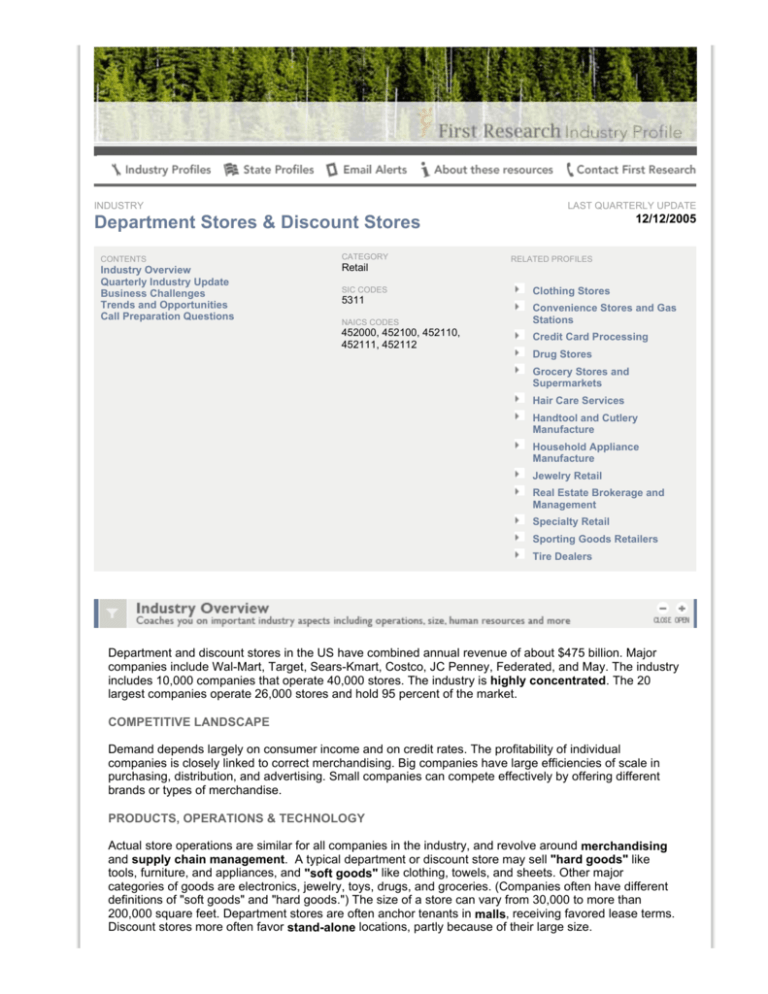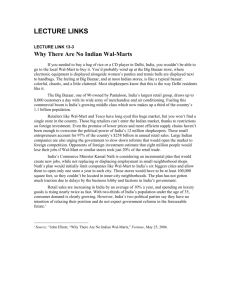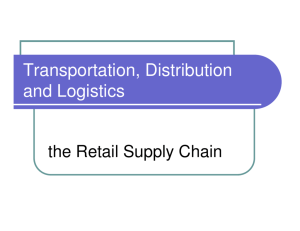
INDUSTRY
LAST QUARTERLY UPDATE
12/12/2005
Department Stores & Discount Stores
CONTENTS
CATEGORY
Industry Overview
Quarterly Industry Update
Business Challenges
Trends and Opportunities
Call Preparation Questions
SIC CODES
Retail
5311
NAICS CODES
452000, 452100, 452110,
452111, 452112
RELATED PROFILES
Clothing Stores
Convenience Stores and Gas
Stations
Credit Card Processing
Drug Stores
Grocery Stores and
Supermarkets
Hair Care Services
Handtool and Cutlery
Manufacture
Household Appliance
Manufacture
Jewelry Retail
Real Estate Brokerage and
Management
Specialty Retail
Sporting Goods Retailers
Tire Dealers
Department and discount stores in the US have combined annual revenue of about $475 billion. Major
companies include Wal-Mart, Target, Sears-Kmart, Costco, JC Penney, Federated, and May. The industry
includes 10,000 companies that operate 40,000 stores. The industry is highly concentrated. The 20
largest companies operate 26,000 stores and hold 95 percent of the market.
COMPETITIVE LANDSCAPE
Demand depends largely on consumer income and on credit rates. The profitability of individual
companies is closely linked to correct merchandising. Big companies have large efficiencies of scale in
purchasing, distribution, and advertising. Small companies can compete effectively by offering different
brands or types of merchandise.
PRODUCTS, OPERATIONS & TECHNOLOGY
Actual store operations are similar for all companies in the industry, and revolve around merchandising
and supply chain management. A typical department or discount store may sell "hard goods" like
tools, furniture, and appliances, and "soft goods" like clothing, towels, and sheets. Other major
categories of goods are electronics, jewelry, toys, drugs, and groceries. (Companies often have different
definitions of "soft goods" and "hard goods.") The size of a store can vary from 30,000 to more than
200,000 square feet. Department stores are often anchor tenants in malls, receiving favored lease terms.
Discount stores more often favor stand-alone locations, partly because of their large size.
Each company usually has a specific merchandising strategy: deciding what categories of goods to sell
and which items to sell in each category, to attract a particular kind of customer. The merchandise mix
varies considerably at different companies, with traditional department stores usually selling a higher
percentage of soft goods. Wal-Mart gets about 20 percent of its revenue from the sale of soft goods, 20
percent from hard goods, 10 percent from drugs, 10 percent from electronics, and 25 percent from
groceries. Dillard's, a more traditional department store chain, gets more than half of its revenue from
sales of soft goods.
Companies in the industry can be stratified by price, with conventional department store operators selling
higher-priced goods, discounters selling lower-priced goods, and warehouse clubs selling goods at rockbottom prices. The distinctions are sometimes blurred. Some large companies operate a number of
chains, each targeting a slightly different type of customer. The mix of goods sold is seasonal. Women's
apparel, in particular, has a fall and spring selling season and is subject to shifts in fashion. Because of the
Christmas season, many stores build inventories in late fall and generate close to a third of revenue in
fourth quarter.
Supply chain management includes supplier relationships, product distribution, and inventory
management. A large company like JC Penney buys from 2,600 suppliers (both manufacturers and
distributors), and may carry 50,000 different SKUs (stock keeping units). Although companies may have
long-term relationships with suppliers, there are few long-term contracts. Goods are usually bought on
credit. Costco sells many items so quickly that it receives sales revenue before it has to pay suppliers.
Companies with multiple stores usually resupply each store from one or several distribution centers.
Warehouse clubs, like Costco, cut costs by eliminating distribution centers and receiving goods at each
store directly from the manufacturer.
Computer systems have become essential for department and discount stores, both for supply chain
management and to collect marketing information. Wal-Mart pioneered sophisticated computerized
inventory control systems that are now widely imitated in the industry. Such systems use point-of-sale
(POS) terminals to capture detailed information about each item sold, produce automatic reordering from
suppliers, and generate management reports that show which items are selling well or poorly. Wal-Mart
recently pioneered the use of radio-frequency identification tags (RFID) to track shipments from
suppliers.
SALES & MARKETING
Department and discount stores are heavy users of newspaper and TV advertising, and of newspaper
inserts, direct mail, and radio; advertising commonly equals 5 percent of cost of sales. Pricing strategies
vary widely: some companies have frequent sales or regular price markdowns, while others keep prices
firm. Companies measure the effectiveness of their merchandising by tracking annual net sales per
square foot of retail space. This measure is not necessarily higher for higher-priced stores. Recently, the
upscale Lord & Taylor chain of May Department Stores had net sales of about $170 per square foot, while
moderately-priced Kohl's had net sales of $285 per square foot.
Taking a cue from other industries, some companies run rewards programs for frequent shoppers,
sometimes in conjunction with shopping mall operators. Frequent-shopper cards are an important source
of shopping and marketing information and can be used for targeted marketing programs.
FINANCE & REGULATION
Because of the Christmas season, many stores build their inventories in late fall and generate close to a
third of their revenue in fourth quarter. The level of inventories depends partly on the type of
merchandise. Recently, Dillard's, which sells mainly soft goods, had inventory turnover of just 3 times per
year, while Costco, which sells many food items, turned inventory 12 times per year.
Most purchases at most department stores are with credit cards that may be issued by the company,
third parties, or third parties in association with the company. Third-party credit card issuers typically
charge a company a fee of 1 to 3 percent on purchases made with their card. To cut costs, some
warehouse clubs don't accept credit cards. Some larger companies operate their own credit operations,
while others offer a private label credit card operated by a third party. Some companies may require that
credit purchases be made only with their credit card. Some companies issue two credit cards: one has
typical third-party requirements, and one has more liberal credit standards but can be used only at
company stores.
The retail trade industry is lightly regulated. State and federal regulations are designed mainly to prevent
deceptive advertising and sales practices; ensure safe conditions (especially in warehouse stores); and
prevent the exploitation of low-paid workers.
REGIONAL & INTERNATIONAL ISSUES
Growth in consumer demand is mainly due to changes in local population or income. The states with the
fastest population growth in recent years were Nevada, Arizona, Florida, Georgia, Texas, and Idaho.
An increasing percentage of goods sold by department and discount stores is made abroad, especially in
low-cost countries like China, Mexico, and Hong Kong. China is now the largest importer to the US of
clothes, shoes, towels, and other textile products.
HUMAN RESOURCES
Most jobs in department and discount stores involve sales or inventory stocking, and therefore require no
extensive training or education. Companies usually have a mix of full- and part-time employees because
sales volume varies during the day, week, and year. Sales and stocking employees generally earn low
wages; employee turnover can therefore be high and training is required for a steady stream of new
employees.
Industry Employment Growth
Bureau of Labor Statistics
Average Hourly Earnings & Annual Wage Increase
Bureau of Labor Statistics
Organic Gets Big...and Controversial - Consumers are increasingly demanding organic products from
large discount chains, and new Congressional legislation may make getting organic foods easier. The
agriculture appropriations subcommittee has introduced a provision that allows some artificial ingredients
in organic food production, which has many organic consumer advocacy groups up in arms. However, as
consumer demand for organic products increases, retailers such as Wal-Mart, Target, and Costco must
find ways to increase production from traditionally small organic producers.
Promising Consumer Holiday Spending Forecast - Average consumer holiday spending could top
$738 in 2005, compared to $702 in 2004, according to the National Retail Federation. Consumer dollars
will go primarily to department (82 percent) and discount stores (77 percent), according to the ExperianGallup Personal Credit Index. Higher consumer spending is excellent news for department and discount
stores, which will be looking to boost overall sales, despite predictions from Experian-Gallup that up to
one-third of consumers will spend less than in 2004.
Supercenters Lose One Competitor - Super Kmart centers will soon be a thing of the past due to
Kmart's new partnership with Sears. Sears plans to introduce a new version of the supercenter that
emphasizes food items less. While Kmart has foregone the super center concept, Wal-Mart and Target will
continue to add supercenters to satisfy consumer demand. Wal-Mart continues to lead, and currently
commands 25 percent of the consumer food market, according to industry analysts.
Black Friday Scandal - Websites are popping up that leak Black Friday discounts well in advance of the
sale date, angering many large retailers. The day after Thanksgiving, called Black Friday by insiders, is
one of the biggest shopping days of the year for many chains. The items stores use to attract customers
on Black Friday can determine how much traffic they'll see on this important sale day. Some retailers,
including Target and Wal-Mart, have filed lawsuits on the grounds that the advertisements, typically not
released until Thanksgiving Day, are copyrighted.
Retailers Using Databases to Combat Organized Crime - Retailers, including Federated Department
Stores, Wal-Mart, and Target, are increasingly using national databases to store and share shoplifting
information to combat organized shoplifting operations. The amount of loss from shoplifting has
traditionally been kept secret by retailers, but many are realizing that sharing information may prevent
organized rings of thieves from hitting multiple stores in a single region. In addition to pursuing database
technology, industry groups advocate stronger federal anti-shoplifting laws.
CRITICAL ISSUES
Revenue Linked to Consumer Spending - Unlike retailers of essential goods like food and drugs,
department stores sell items that consumers don't need to buy when finances are tight. Higher-price
department stores are especially vulnerable to economic slowdowns. During the latest recession, total
revenue at conventional department stores fell 8 percent; revenue at discount department stores was flat.
Department store retail sales dropped 0.4 percent in the first ten months of 2005 compared to
year-ago.
Rapid Industry Consolidation - Large economies of scale in purchasing and marketing have driven rapid
consolidation in the industry. Discount and superstores increased their share of industry revenue from 60
percent in 1994 to 75 percent in 2004. The eight largest companies now hold more than 80 percent of the
market. Wal-Mart accounts for more than 50 percent of industry revenue.
Discounter Kmart recently bought Sears in a $12.3 billion deal that created the third-largest US
retailer, Sears Holdings Corp.
OTHER BUSINESS CHALLENGES
Exposure to Credit Conditions - Companies that operate their own credit card operations are vulnerable
to changing credit conditions. During the 2001 recession, Sears saw credit card delinquencies rise to 10
percent. Annual credit card charge-offs are typically more than 5 percent.
Revenue Subject to Fashion - Department stores that have shed hard goods departments depend more
on apparel and other fashion-oriented goods. Several large chains have had financial difficulties in recent
years because consumers didn't like their fashions. By becoming more like clothing stores, department
stores are likely to have more volatile revenues and earnings.
Profitability Highly Seasonal - Like many other retailers, department stores get the largest share of
revenue and profits in fourth quarter, as consumers shop for the Christmas season. Because goods must
be ordered from manufacturers well in advance, profitability for the entire year can depend on managers
making the right forecast about consumer demand for Christmas goods.
Consumers Expect Quality at Low Prices - Improvements in US and foreign manufacturing techniques
now allow merchants to sell good quality products at very low prices; consequently, consumers now buy
more products from retailers that emphasize low prices. In the past decade, annual revenue for warehouse
clubs grew 250 percent.
BUSINESS TRENDS
Grocery, Drug Sales - In recent years, large retailers have opened stores that sell groceries and drugs as
well as typical hard and soft goods. Wal-Mart is now one of the largest grocers in the US. While margins
on groceries are usually lower than on other goods, the availability of groceries generates store traffic that
increases sales of other goods. Both Kmart and Target have followed Wal-Mart's strategy by building
superstores that combine sales of groceries and other goods.
Leased Departments - Many department stores contain departments operated by an outside retailer.
These may be departments for an entire category of goods, such as jewelry, or departments that contain a
single brand line of goods.
Centralized Merchandising - Because of the critical role that merchandising plays, most large companies
in the industry use a central staff to make all merchandising decisions and purchases. In smaller
companies, store managers often have a greater influence on merchandising decisions.
Fewer Suppliers - To increase buying power, some large retailers buy a larger volume of goods from a
smaller number of big suppliers. Although volume purchases produce lower prices, they also result in a
smaller selection for customers and greater identification of a particular brand with a particular retailer. The
growth of large chains like Wal-Mart requires suppliers that are large enough to service a nationwide chain
of stores.
Dollar Store Concept - More traditional retailers, like supermarkets and discount stores, are testing their
own "dollar" sections to compete with successful chains like Dollar General, Family Dollar, Dollar Tree,
and 99 Cents Only. The dollar store sector has been consolidating as major chain discounters squeeze
out small mom-and-pop stores and introduce modern retailing techniques, according to retail analysts.
INDUSTRY OPPORTUNITIES
Catalog, Internet Sales - The success of catalog merchants like LL Bean has prompted many retailers to
open or acquire catalog and Internet operations. The large distribution systems of the bigger companies
lend themselves very easily to such non-store sales. The volume of Internet sales remains small
compared to traditional store sales, but catalog sales can make a large contribution to revenue.
Diversification, Specialty Stores - Large companies in the industry usually operate a number of retail
chains that sell products to different types of customers or that sell different types of products altogether.
The merchandising, retailing, or distribution skills that allow one chain to be successful can often be
transferred to another. Federated Department Stores operates seven department store chains and a chain
of furniture stores; May operates a chain of bridal stores and a tuxedo rental business; Sears operates
specialty chains that sell hardware, tires and batteries, and home decorating.
Smaller Markets - While many national chains have been successful by operating large stores with a
variety of goods, some are trying to sell to smaller markets by offering smaller stores. Kohl's has been
testing stores of 62,000 square feet (compared to 89,000 square feet for its regular stores) for markets
with populations of 100,000 or less.
Private Label Goods - Many department and discount stores market their own private brands. Such
goods have higher margins than brand-name goods, even though they're usually priced lower. Some
private labels, such as Sears' Craftsman, Diehard, Kenmore, and Land's End brands, or Kmart's licensed
Martha Stewart brand, are as well known as national brands.
Anchor Tenants for Malls - Despite the rise of freestanding mega-stores like Wal-Mart, many real estate
developers still build strip or enclosed malls with department stores as anchor tenants (with favorable
lease terms). To a large extent, enclosed malls are the equivalent of traditional department stores, except
that the departments are now separate stores specializing in electronics, jewelry, furniture, etc.
CONVERSATION STARTERS
How does the company mitigate shifts in consumer spending?
Unlike retailers of essential goods like food and drugs, department stores sell items that consumers don't
need to buy when finances are tight.
Does the company compete against national chains, mass merchants, and specialty stores?
Large economies of scale in purchasing and marketing have driven rapid consolidation in the industry.
How does the company reduce risk associated with offering a store credit card?
Companies that operate their own credit card operations are vulnerable to changing credit conditions.
What benefits or challenges have come with giving customers catalog and Internet purchase
options?
The success of catalog merchants like LL Bean has prompted many retailers to open or acquire catalog
and Internet operations.
What plans does the company have for store or product diversification in the near future?
Large companies in the industry usually operate a number of retail chains that sell products to different
types of customers or that sell different types of products altogether.
What opportunities or obstacles does the company see in opening scaled-down stores in small,
underserved communities?
While many national chains have been successful by operating large stores with a variety of goods, some
are trying to sell to smaller markets by offering smaller stores.
QUARTERLY INDUSTRY UPDATE QUESTIONS
How does the company promote winter holiday sales?
Beyond copyright infringements, some retailers feel that advertising holiday sales on websites could be
used by competitors to undercut discounts and lure customers away.
How can the company use databases to discourage shoplifting and organized crime?
Databases allow for data collection and sharing among retailers. Users of the system hope that by sharing
information, they can spot patterns of shoplifting and contact the appropriate authorities.
OPERATIONS, PRODUCTS AND FACILITIES QUESTIONS
How many stores does the company operate?
Only 700 companies in the US operate more than one department/discount store.
How large are the stores?
A typical Kohl's store has 89,000 square feet; some mega-stores have 200,000.
Does the company operate a distribution center?
Companies with multiple stores usually receive goods at a distribution center.
Does the company consider its stores department, discount, or warehouse clubs?
The distinction is sometimes difficult to make.
Does the company operate other kinds of stores?
Some large companies operate several chains and also specialty stores.
Are company stores freestanding or in malls?
Freestanding stores have become more common, especially as size has increased.
What mix of soft goods, hard goods, and other goods does the company sell?
The trend has been for stores to sell more soft goods like clothes and home furnishings, and fewer hard
goods like tools and furniture.
Does the company sell groceries and drugs in its stores?
Groceries in general merchandise stores are a recent development. Drugstores are more common.
How many suppliers does the company use?
A national chain may use 2,500 to 4,000 suppliers.
Does the company have any multiyear supply contracts?
Multiyear contracts are unusual.
How many items does the company sell in its stores?
A large store may have 50,000 stock keeping units (SKUs).
Does the company sell private-label goods? What percentage of revenue?
Many large companies sell private-label goods.
Does the company lease space in its stores to other merchants?
Jewelers and brand name merchants are typical renters of space.
CUSTOMERS, MARKETING, PRICING, COMPETITION QUESTIONS
What kind of customer does the company target?
Many companies target customers by income level.
What types of marketing does the company use?
Newspaper ads are a major channel. Companies typically also use TV, radio, inserts, and direct mail.
What pricing strategy does the company use?
Some companies have frequent sales, some have predictable markdowns, some never cut prices.
Does the company have programs to reward frequent shoppers?
Many companies issue discount cards, which can also be used to acquire detailed information about
shopping habits.
How large a geographical area does a company store serve?
Companies sometimes ask shoppers for zip code information to measure geographical coverage.
Does the company compete with national chains like Wal-Mart?
How is the store trying to differentiate itself?
Department stores are differentiating themselves either at high-end through product exclusivity or
customer service, or at low-end with discounts.
REGULATIONS, R&D, IMPORTS, AND EXPORTS QUESTIONS
Has the company had any difficulty complying with FTC or labor law regulations?
ORGANIZATION AND MANAGEMENT QUESTIONS
How much autonomy do store managers have about merchandising and pricing?
Large companies often have a centralized merchandising staff.
What percentage of store employees work part-time?
What is the typical annual employee turnover?
Because of low pay for salespeople, turnover can be high.
What sort of training do new employees receive?
Because of employee turnover, some companies have a permanent training program.
FINANCIAL ANALYSIS QUESTIONS
How seasonal are the company's revenue and cash flow?
Typically, 30 percent of revenue and an even larger percent of profits come in fourth quarter.
How much do inventories fluctuate throughout the year?
Inventories often build early in fourth quarter in anticipation of Christmas, and for the fall and spring
clothing seasons.
What is the average sale per purchase?
Does the company accept credit card purchases?
Some warehouse clubs accept only cash or checks. Some companies accept only their proprietary credit
card.
What percentage of purchases is made with credit cards?
Does the company operate its own credit card program?
Some companies operate their own program; some offer a private label credit card in partnership with a
third-party bank. Credit card programs are difficult to operate profitably.
What is the average fee the company pays for third-party credit card purchases?
This can range from 1 to 3 percent of sales.
What is the latest annual revenue per square foot of retail space?
Recently, Kohl's had revenue of $285 per square foot; May had $170.
Does the company own or lease its stores?
Leasing is usual, especially in malls.
Does the company hold long-term leases for its space? What is the average annual leasing cost
per square foot?
Large freestanding stores may require long-term leases with developers. Typical lease costs are $20 per
square foot, but can vary widely.
How much does the company spend per year to refurbish and redecorate stores?
How much has the company spent in recent years for computer systems?
Advanced computer systems have been a major ingredient in Wal-Mart's success.
BUSINESS AND TECHNOLOGY STRATEGIES QUESTIONS
Does the company plan to open new stores?
Companies like Kohl's have rapidly expanded by duplicating a successful concept.
Does the company plan to change its merchandise mix?
Many department stores have gravitated to more soft goods.
Does the company plan to add major merchandise lines, such as groceries or drugs?
Does the company plan to open specialty stores that take advantage of its distribution system and
name recognition?
Does the company plan "store within a store" partnerships with other retailers?
Does the company provide customers the option of catalog and Internet purchases?
Most major companies now operate Internet shopping sites.
Does the company plan to spend heavily on computer systems?
“The purpose of the Profiles is for sales call preparation and general business and industry analysis. Profiles provide
general background information only and are not intended to furnish detailed information about the creditworthiness of
any individual borrower or purchaser or to be used for making any loans, leases or extension of credit to any individual
borrower or purchaser. First Research, Inc. is not an investment advisor, nor is it in the business of advising others as to
the value of securities or the advisability of investing in securities, and the Profiles are not intended to be relied upon or
used for investment purposes.”
© Copyright 2005, First Research, Inc. All Rights Reserved.
This information cannot be copied, sold or distributed in any manner without the written permission of
First Research, Inc. www.firstresearch.com







